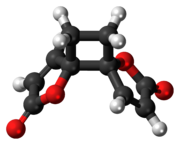
| |

| |
| Names | |
|---|---|
| IUPAC names
trans-4,7-Dioxadispirododeca-1,9-diene-3,8-dione trans-1,7-Dioxadispirododeca-3,9-diene-2,8-dione | |
| Identifiers | |
| CAS Number | |
| 3D model (JSmol) | |
| ChEMBL | |
| ChemSpider | |
| PubChem CID | |
| UNII | |
| CompTox Dashboard (EPA) | |
InChI
| |
SMILES
| |
| Properties | |
| Chemical formula | C10H8O4 |
| Molar mass | 192.170 g·mol |
| Appearance | Colourless, odourless solid |
| Density | 1.45g/cm |
| Melting point | 158 °C (316 °F; 431 K) |
| Boiling point | 535.7 °C (996.3 °F; 808.9 K) @ 760mmHg |
| Solubility in water | low |
| Solubility in chloroform | very soluble |
| Hazards | |
| Flash point | 300.7 °C (573.3 °F; 573.8 K) |
| Lethal dose or concentration (LD, LC): | |
| LD50 (median dose) | 150 mg·kg (mouse, IP) |
| Except where otherwise noted, data are given for materials in their standard state (at 25 °C , 100 kPa).
| |
Anemonin is a tri-spirocyclic dibutenolide natural product found in members of the buttercup family (Ranunculaceae) such as Ranunculus bulbosus, R. ficaria, R. sardous, R. sceleratus, and Clematis hirsutissima. Originally isolated in 1792 by M. Heyer, It is the dimerization product of the toxin protoanemonin. One of the likely active agents in plants used in Chinese medicine as an anti-inflammatory and Native American medicine as a horse stimulant, its unique biological properties give it pharmaceutical potential as an anti-inflammatory and cosmetic agent.
Biosynthetic origins
 Protoanemonin
Protoanemonin Ranunculin
Ranunculin
Anemonin is a homodimer formed from two protoanemonin subunits. Protoanemonin is formed from the enzymatic cleavage of ranunculin upon crushing plant matter. When a plant from this family is injured, a β-glucosidase cleaves ranunculin, liberating protoanemonin from glucose as a defense mechanism. This butenolide readily dimerizes in aqueous media to form a single cyclodimer.
Chemical structure and proposed mechanism of formation
Despite multiple possibilities, X-ray crystallography of the solid anemonin has revealed that the two rings exclusively possess a trans relationship. The central cyclobutane ring was found to be bent to a dihedral angle of 152°. NMR spectroscopy reveals that the central ring is also twisted 9-11°.
The highly selective formation of the head-to-head dimer has been rationalized through the stability of a proposed diradical intermediate; the resulting radicals after an initial carbon-carbon bond forming step are delocalized through the α,β-unsaturated system. These proposed radicals could also be stabilized through the captodative effect, as they are situated between the enone and sp3-hybridized oxygen of the butenolides.
Destabilizing dipole-dipole interactions are proposed to disfavor the transition state where the two butenolide rings adopt a cis conformation, leading to selectivity of a trans relationship between the lactone rings.
The formation of anemonin from protoanemonin is most likely a photochemical process. When Kataoka et. al compared the dimerization of protoanemonin in the presence and absence of radiation from a mercury lamp, they found a 75% yield with radiation and a very poor yield without radiation. It is not mentioned whether light was excluded from this control reaction; the low yield of anemonin may arise from visible light-mediated dimerization of protoanemonin.
Pharmaceutical potential
Anemonin possesses anti-inflammatory properties rather than the vesicant properties of its parent monomer. Numerous studies have demonstrated anemonin’s potential in treating ulcerative colitis, cerebral ischemia, and arthritis. Its activity against LPS-related inflammation and nitric oxide production contribute to its pharmaceutical potential. Anemonin also displays inhibition of melanin production in human melanocytes with mild cytotoxicity.
Given its skin permeability in ethanolic solutions and its anti-inflammatory and anti-pigmentation properties, anemonin may be a good candidate for topical formulations as arthritis medications or cosmetics. An extraction method with the potential for industrial-scale preparations of anemonin may provide inroads to drug development.
References
- ^ William M. Haynes (2016). CRC Handbook of Chemistry and Physics (97th ed.). Boca Raton: CRC Press. pp. 3–26. ISBN 978-1-4987-5429-3.
- Teodora N, Neli Kinga O, Daniela H, Daniela B, Pripon F, Aurel A, Claudia T (2018). "Anemonin Content of Four Different Ranunculus Species". Pakistan Journal of Pharmaceutical Sciences. 31 (5(Supplementary)): 2027–2032. PMID 30393208.
- ^ Kern JR, Cardellina JH (July 1983). "Native American medicinal plants. Anemonin from the horse stimulant Clematis hirsutissima". Journal of Ethnopharmacology. 8 (1): 121–123. doi:10.1016/0378-8741(83)90093-4. PMID 6632934.
- ^ Moriarty RM, Romain CR, Karle IL, Karle J (July 1965). "The Structure of Anemonin". Journal of the American Chemical Society. 87 (14): 3251–3252. doi:10.1021/ja01092a047. ISSN 0002-7863.
- "Aktuelles aus der Natur" (PDF) (in German). TU Graz. 2 April 2009. p. 4. Retrieved 27 November 2010.
- ^ Duan H, Zhang Y, Xu J, Qiao J, Suo Z, Hu G, Mu X (April 2006). "Effect of anemonin on NO, ET-1 and ICAM-1 production in rat intestinal microvascular endothelial cells". Journal of Ethnopharmacology. 104 (3): 362–366. doi:10.1016/j.jep.2005.09.034. PMID 16257161.
- Pirvu L, Stefaniu A, Neagu G, Pintilie L (2022-01-01). "Studies on Anemone nemorosa L. extracts; polyphenols profile, antioxidant activity, and effects on Caco-2 cells by in vitro and in silico studies". Open Chemistry. 20 (1): 299–312. doi:10.1515/chem-2022-0137. ISSN 2391-5420.
- Karle IL, Karle J (1966-04-10). "The crystal and molecular structure of anemonin, C10H8O4". Acta Crystallographica. 20 (4): 555–559. Bibcode:1966AcCry..20..555K. doi:10.1107/S0365110X66001233. ISSN 0365-110X.
- Lustig E, Moriarty RM (July 1965). "The Estimation of the Angle of Twist for a Cyclobutane Derivative by Nuclear Magnetic Resonance". Journal of the American Chemical Society. 87 (14): 3252–3253. doi:10.1021/ja01092a048. ISSN 0002-7863.
- Kataoka H, Yamada K, Sugiyama N (November 1965). "The Photo-synthesis of Anemonin from Protoanemonin". Bulletin of the Chemical Society of Japan. 38 (11): 2027. doi:10.1246/bcsj.38.2027. ISSN 0009-2673.
- Jiang L, Chi C, Yuan F, Lu M, Hu D, Wang L, Liu X (March 2022). "Anti-inflammatory effects of anemonin on acute ulcerative colitis via targeted regulation of protein kinase C-θ". Chinese Medicine. 17 (1): 39. doi:10.1186/s13020-022-00599-3. PMC 8962473. PMID 35346284.
- Jia D, Han B, Yang S, Zhao J (June 2014). "Anemonin alleviates nerve injury after cerebral ischemia and reperfusion (i/r) in rats by improving antioxidant activities and inhibiting apoptosis pathway". Journal of Molecular Neuroscience. 53 (2): 271–279. doi:10.1007/s12031-013-0217-z. PMID 24443273. S2CID 255492187.
- ^ Hou H, Peng Q, Wang S, Zhang Y, Cao J, Deng Y, et al. (2020). "Anemonin Attenuates RANKL-Induced Osteoclastogenesis and Ameliorates LPS-Induced Inflammatory Bone Loss in Mice via Modulation of NFATc1". Frontiers in Pharmacology. 10: 1696. doi:10.3389/fphar.2019.01696. PMC 7025528. PMID 32116686.
- Wang Z, Huang J, Zhou S, Luo F, Xu W, Wang Q, et al. (December 2017). "Anemonin attenuates osteoarthritis progression through inhibiting the activation of IL-1β/NF-κB pathway". Journal of Cellular and Molecular Medicine. 21 (12): 3231–3243. doi:10.1111/jcmm.13227. PMC 5706500. PMID 28643466.
- Xiao K, Cao ST, Jiao LE, Lin FH, Wang L, Hu CH (July 2016). "Anemonin improves intestinal barrier restoration and influences TGF-β1 and EGFR signaling pathways in LPS-challenged piglets". Innate Immunity. 22 (5): 344–352. doi:10.1177/1753425916648223. PMID 27189428. S2CID 12372791.
- Lee TH, Huang NK, Lai TC, Yang AT, Wang GJ (March 2008). "Anemonin, from Clematis crassifolia, potent and selective inducible nitric oxide synthase inhibitor". Journal of Ethnopharmacology. 116 (3): 518–527. doi:10.1016/j.jep.2007.12.019. PMID 18281171.
- Huang YH, Lee TH, Chan KJ, Hsu FL, Wu YC, Lee MH (February 2008). "Anemonin is a natural bioactive compound that can regulate tyrosinase-related proteins and mRNA in human melanocytes". Journal of Dermatological Science. 49 (2): 115–123. doi:10.1016/j.jdermsci.2007.07.008. PMID 17766092.
- Ning Y, Rao Y, Yu Z, Liang W, Li F (March 2016). "Skin permeation profile and anti-inflammatory effect of anemonin extracted from weilingxian". Die Pharmazie. 71 (3): 134–138. PMID 27183707.
- CN101759706B, 王琳 & 范淦彬, "Method for manufacturing anemonin", issued 2012-01-11